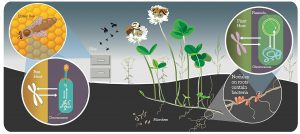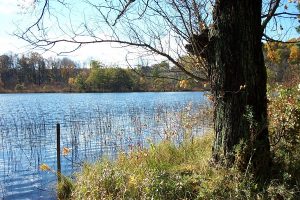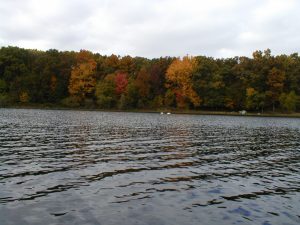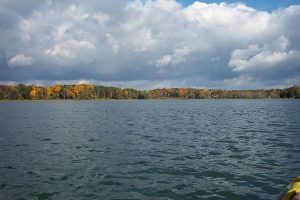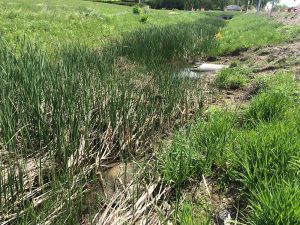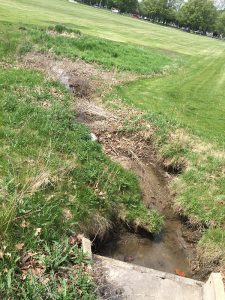Community ecology of disease
Collaborative research with Spencer Hall, Meghan Duffy, and Zoi Rapti
As new diseases continue to appear in animal populations, ecologists are increasingly faced with answering questions regarding the distribution and prevalence of infection. In some disease systems, it has become clear that species other than the focal host and parasite–such as those that provide food for hosts, compete with hosts for food, and prey on sick hosts–can inhibit or facilitate disease spread. Therefore, interactions with other species may influence the distribution of disease. However, finding mechanistic explanations in this web of direct and indirect effects requires merging aspects of evolutionary biology and epidemiology with community ecology. To make these connections, we have been exploiting an experimentally tractable disease system by using an aquatic parasite (the fungus Metschnikowia bicuspidata) and its host (Daphnia). We build on our own work, as well as that of others, to integrate the role of Daphnia as grazers of algae, as competitors with other zooplankton for that algae, and as prey for fishes and invertebrates. Each of these interactions likely influences disease spread among the hosts. We approach our system with data-theory integration. We construct mathematical models, refine those models using experiments, and test model predictions with observations of epidemics.
Ecology of stormwater habitats
Collaborative research with Brian Allan, Chris Holmes, Juma Muturi, Allison Hansen, and Zoi Rapti
Anthropogenic change of the landscape is occurring at unprecedented rates, representing a massive and unplanned ecological experiment affecting both species diversity and the quality of their associated habitats. Typically associated with urbanization is the creation of urban stormwater habitats. These novel stormwater ponds provide us with a unique opportunity to apply ecological and evolutionary theory to better understand the mechanisms underlying the creation and maintenance of biodiversity. Inhabitants of stormwater ponds include larval mosquitoes, which in their adult life-stage vector human diseases. Little is known about the food web structure of these habitats, which limits our ability to predict how ecological interactions may influence disease transmission. We are coupling field and laboratory manipulative experiments with mathematical theory to address how ecological interactions in these freshwater ponds influence the abundance and distribution of mosquitoes across the landscape.
Before an adult female mosquito can transmit a disease to a human, however, juvenile mosquitoes must successfully survive development in an aquatic habitat. Recent scientific advances have the potential to transform the understanding of which factors are most important in determining species distributions and abundances, including the recognition that all animal guts harbor complex communities of microbes, known as the gut microbiome, and that this microbial community has the potential to influence the survival and reproduction of that animal in unexpected ways. This research examines how a complex set of interactions between the free living microbes, the gut microbiome, the host mosquito, and other members of the aquatic food web, can result in variation in mosquito growth and survival to adulthood, which ultimately affects human disease risk.
Our goal is to quantify the feedbacks that govern how communities assemble simultaneously across hierarchical scales from the repeated assembly of food webs in temporary aquatic habitats to the simultaneous assembly of the gut microbiome of individual mosquitoes colonizing those food webs. Two interrelated questions will be addressed using field and laboratory experiments: Is the assembly of the gut microbiota of two important mosquito vectors driven by the corresponding assembly of the invertebrate food web? Do microbiome-driven differences in the growth rate of community members influence invertebrate community assembly? The focus on food webs and microbial communities that assemble in larval mosquito habitats also provides a link between community ecology, microbial ecology, and disease ecology.
Genomics and Eco-evolution of Multi-Scale Symbioses (GEMS)
Collaborative research with an amazing group of scholars
We live in a microbial world. Microbes and viruses infect, interact, and move through the genomes of every organism on Earth. Relationships among organisms, and with their microbes, can dramatically change the traits, behaviors, and functions of the host plant or animal. Sometimes these interactions are beneficial and sometimes they can cause disease. Many microbes influence host function and can have hidden but important global scale impacts, driving the rates of responses to climate change, health and disease, antibiotic resistance, and more. Understanding how nested interactions within the microbial world occur and influence our ecosystems is critical to controlling their impact.
The Genomics and Eco-evolution of Multi-Scale Symbioses (GEMS) Institute, a Biology Integration Institute funded by the National Science Foundation, focuses on the classical species interaction between clover and honey bee pollinators as a model to understand the impact and dynamics of the myriad of microbes nested within them. The project takes an integrative approach to understand how molecular interactions impact the ecosystem. As a $20 billion US industry, the outcomes of the project studying clover/honey bee nested genomes has practical value as well as being a model for addressing fundamental questions in integrative biology. The researchers in GEMS are collaborative, diverse, interactive scientists and educators who take an inter-disciplinary approach to answer critical questions about how nested genomes interact and affect the world. The project uses a shared leadership model with co-mentorship between trainer and trainee and multisite educational activities. The established institute is designed to integrate biological disciplines to understand how nested genomes respond to environmental change.
GEMS will address the fundamental biological question, How do symbioses unify biology, from molecule to ecosystem? The goal of this project is to establish a framework for how the phenotypic variation generated by the mobility of nested symbionts influences the adaptability of traits and the strength and stability of species interactions. Ultimately, the Institute aims to understand how this variation impacts ecosystem responses to environmental change. The Institute is grounded in the canonical symbiosis between flowering plants and insect pollinators (clover and honey bees), expanding to include interactions nested in their microbial world. The research leverages the extensive knowledge in multiple nested interactions (plant–pollinator, legume–rhizobium, honey bee–microbiome) to build connections within and across systems from the molecular processes that govern establishment of symbiosis and extend phenotypic traits to define how they interact and evolve together in the natural world. Data are integrated with ecological and evolutionary theory to generalize beyond the focal systems to build predictive models. Computer science, statistics, and mathematics expand both the range of biological questions asked and the impact of their answers. Along with the traditional academic silos dividing researchers into molecular and organismal units that prevent a unified view of biology are many others, such as those separating microbe from macrobe, plant from animal, student from faculty, education from research, and diversity, equity, and inclusion from science. Through K-12 education in Spanish and targeting excellence with Project Microbe and the Jim Holland program in three urban and rural communities in the Midwest, GEMS focuses on the intersecting goals of changing how biology is done and who does it, unifying biology by including the small but powerful so often overlooked.
